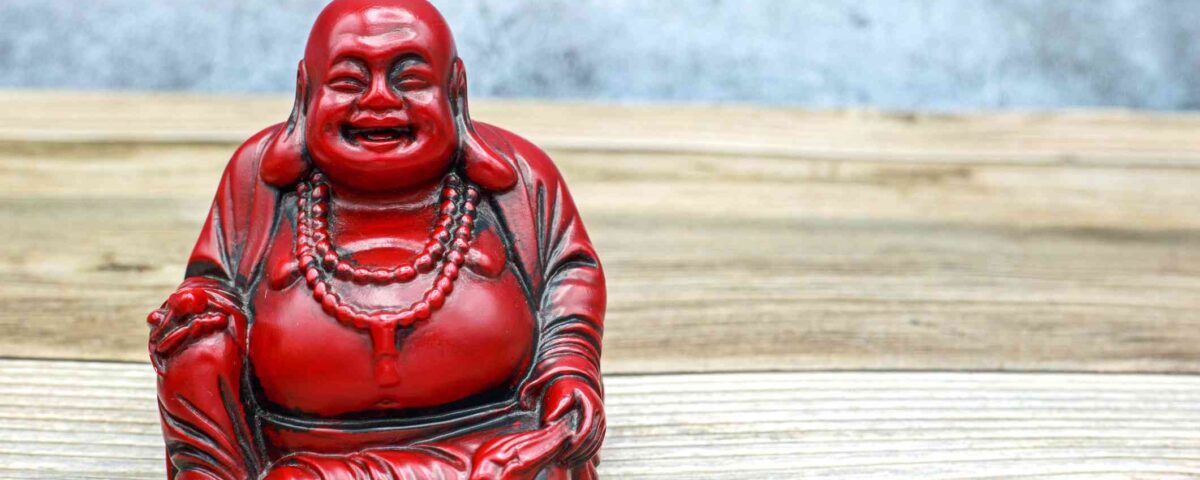Laughing Buddha in Feng Shui

Create the perfect garden
October 12, 2022
Secrets to Landscape Success
October 31, 2022One of the most popularized Buddha images is that of a portly individual with a large pot belly and a laughing face, sitting on a bed of coins. This individual is affectionately known as the Laughing Buddha. Statues of the Laughing Buddha are generally quite easy to find and are a cheerful way to bring some meaning, joy, and abundance into your home.
Who Is the Laughing Buddha?
The Laughing Buddha is depicted as a man with a round belly who is bald and laughing. He has a joyful quality about him. He is typically shown holding a bag in one hand: This represents how he carries your loads and worries for you. The Laughing Buddha enjoys helping others, and he especially loves helping to lighten your load and alleviate the difficulties in your life. In the other hand he holds a mala, which is a beaded necklace with 108 beads that is used for praying and chanting. He’s often found sitting on a bed of coins or other precious treasures. Because he sits on top of valuable items, he can invite abundance and prosperity.
The Laughing Buddha is a modern Buddha and said to be an incarnation of the Maitreya Buddha. The Maitreya Buddha is regarded as one of the future buddhas, or buddhas to come. The Laughing Buddha is a version of the Maitreya Buddha that will come in the future. There’s also a story of a monk named Budai, who is said to be another representation of the Maitreya Buddha. The Maitreya Buddha is a bodhisattva, or an individual who has dedicated their life to the enlightenment of all beings.
Feng Shui and the Laughing Buddha
Since you can find the Laughing Buddha in many shapes, sizes, and materials, you can choose one based on what you are attracted to. If you trust yourself and listen to your intuition, you will usually be drawn to what you need. You can also consider your home decor when choosing a Laughing Buddha, or select one based on your intention. If you want to choose based on a feng shui intention, you can look at the color and material of the Laughing Buddha:
A green jade Laughing Buddha embodies the wood element, which is connected to vitality and growth. It also has some of the qualities of jade, a beautiful stone that has long been treasured in China.
A stone or a brown wood Laughing Buddha is connected to the earth element. Earth represents stability, nourishment, and grounding.
A Laughing Buddha painted red can bring in the fire element. Fire is connected to passion, inspiration, and visibility.
A Laughing Buddha that is painted black represents the water element, which helps to invite more fluidity, wisdom, and introspection.
A Laughing Buddha made of metal, glass, or one that is white represents the metal element. Bringing in the metal element can help you cultivate precision, joy, and beauty.
Small figurine of the Laughing Buddha, also called Budai or Maitreya Buddha, a Chinese monk from the 10th century.
Feng Shui Placements for the Laughing Buddha
As with many spiritual reminders, the Laughing Buddha can be appropriate in different places in your home. The Laughing Buddha in particular can bring the energies of prosperity, joy, and laughter to your household, so you can also think about that symbolism as you are deciding where to place him. Below are a few feng shui suggestions when it comes to locating Laughing Buddha in your home.
Tip
It’s generally advised to avoid placing images of deities (such as the Laughing Buddha) on the floor and in the bedroom.
Entrance
Your home’s entrance is a great place for the Laughing Buddha because this area of your home represents your face to the world. By placing the Laughing Buddha here, you are showing the world that you want to invite this prosperity, joy, and laughter into your life. It also serves as a reminder that you will see every time you come in and out of your home.
Garden
The garden is a wonderful place for the Laughing Buddha because it is a part of your home that is very connected to nature. You can bring a stone Laughing Buddha into the garden to invite in happy nature spirits and to balance the energy in your home and garden.
Wealth Corner
There’s an area of the feng shui bagua map called the wealth corner. You would find this area in your home by standing in your front door, looking into your far left. Because the Laughing Buddha is connected to wealth and prosperity, you may want to strategically place him here. It may also be especially helpful to choose a Laughing Buddha who is sitting on a bed of coins or other treasures for this location. You can even add some precious treasures of your own to that area, and create a little corner to invite in the energy of abundance.
Desk or Home Office
In feng shui, your desk or home office represents your career. You can place the Laughing Buddha on your desk or somewhere in your home office to invite more joy and prosperity into your work.
Living Room
Because the living room is often an area where people tend to spend a lot of time, this can be a great place to put the Laughing Buddha. Placing an image of the Laughing Buddha here can be a daily reminder of joy and abundance, and a way to invite more meaning into your everyday life.
Meditation Area
Your meditation area is a perfect place to put meaningful items with spiritual significance, including images of the Laughing Buddha if that resonates with you. Your meditation altar is a perfect location to place an image of the Buddha or other wisdom deities that represent qualities that you aspire to.






